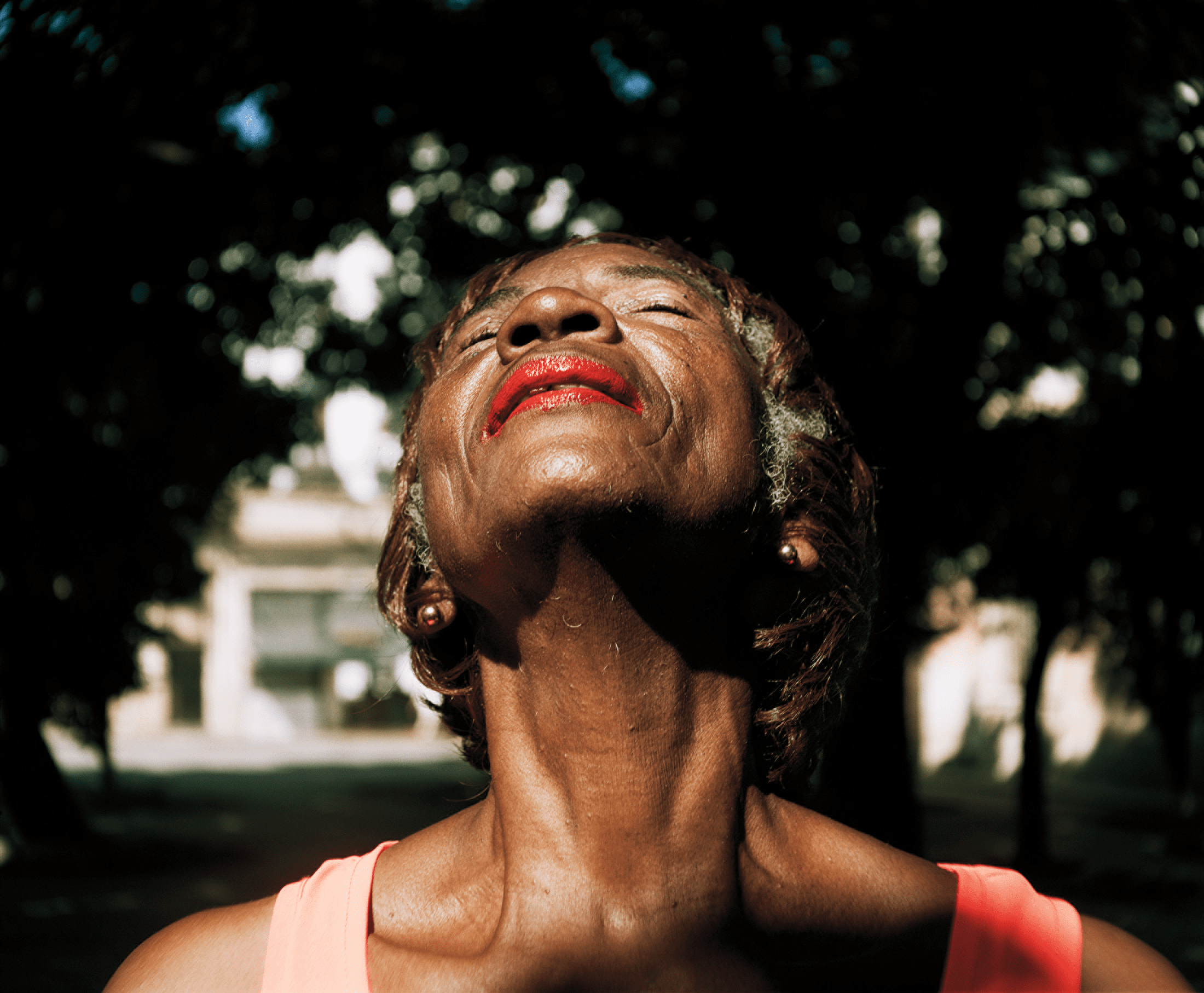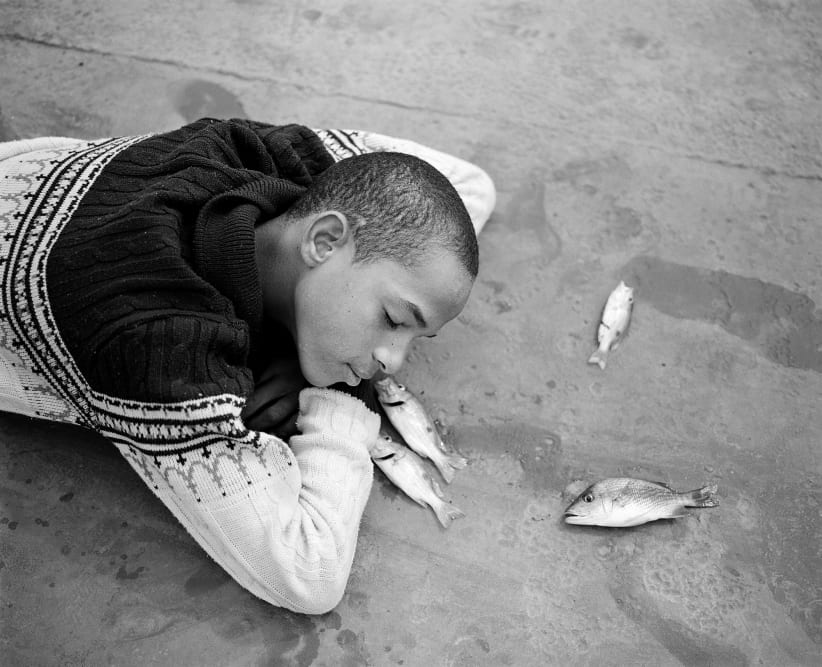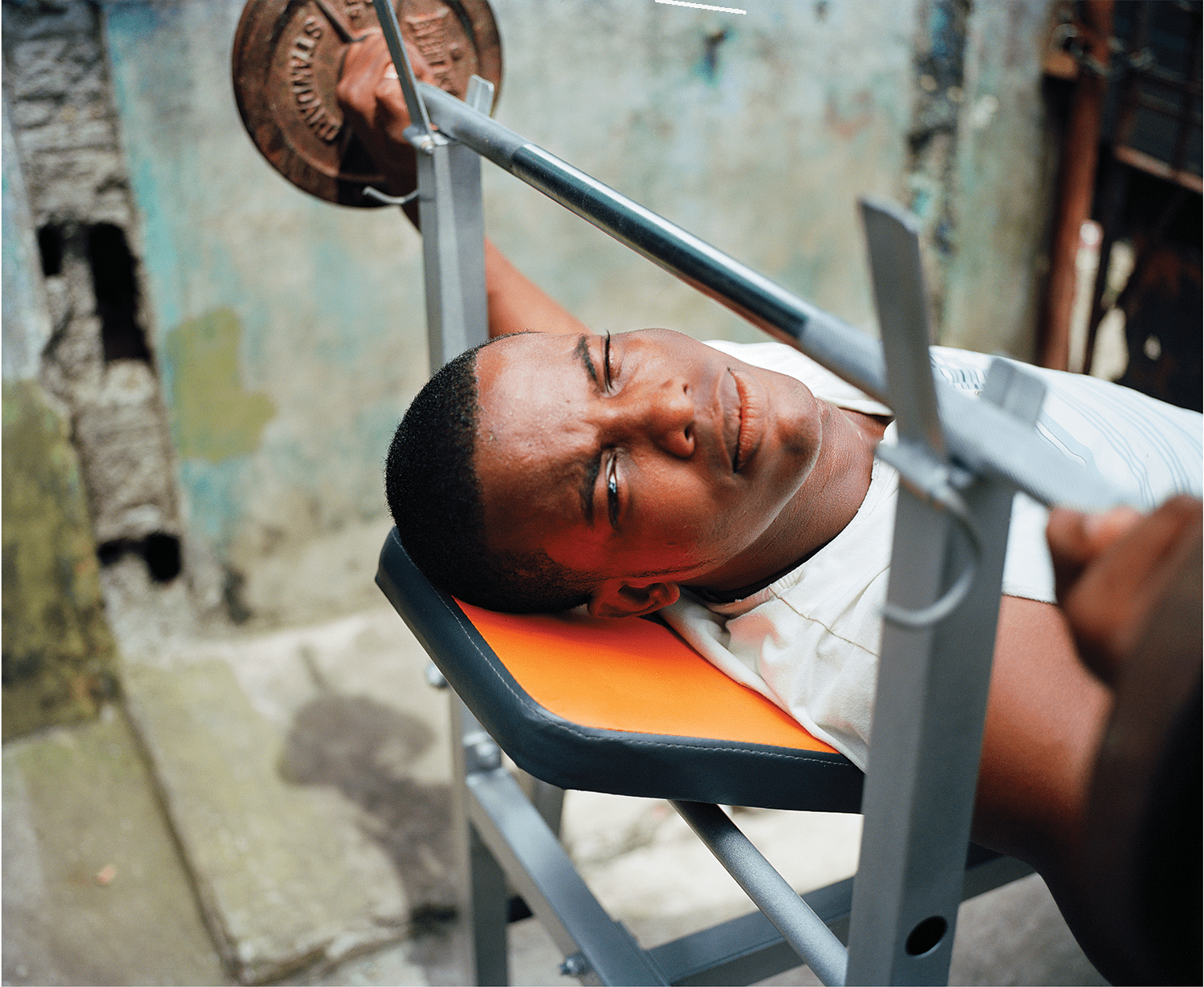A precise definition of “community” is elusive: sure, it refers to a group of people bound by something, but that something is ever-shifting. It can refer to ideology, place, a shared history, or idiosyncratic allegiance. Capturing a community through photographs—and distilling that which binds its members—can be equally, if not more, nebulous, especially if the community is radically different from oneself. A longstanding strategy among image makers is the committed position of embedding, of becoming as much as possible part of the community. Ideally, this does not translate into total absorption, but rather into a one-foot-in, one-foot-out position that allows the pictures to breathe the feeling of inside to those on the outside.
This is a practiced mode for photographer Rose Marie Cromwell. Raised in Seattle and educated at Maryland Institute College of Art and Syracuse University, Cromwell has spent the better part of the last fourteen years working in Latin America, especially in Havana and Panama City, Panama. Her last semi-permanent home in the U.S. was Miami, one of the U.S. cities with the greatest Latino population. Her embrace of Latin American cultures and the Spanish language has translated into openness on the part of the communities she has represented. As peripatetic as they come, Cromwell is also constantly on the move. As we conducted this interview—long-distance, of course—she was traveling through Colombia, with a stopover in the salsa capital of Cali, and at last notice, awaiting her Brazilian visa in the Amazonian town of Leticia. Cromwell and I met a few years ago through a mutual Panamanian friend and have collaborated in different capacities on published stories and an exhibition. Given the collaborative basis of our friendship, I was especially intrigued for us to discuss more in depth how the concept of community threads through her photographic work and practice.
Paula Kupfer (PK): I see a strong focus on community running through most of your projects. What is the meaning of community to you, and how have you engaged with it in your work?
Rose Marie Cromwell (RMC): I’m wary of the word “community” in my practice because I think it is used too broadly. I think specificity is really important. It helps avoid clichés and generalizations. I’ve heard Carrie Mae Weems explain that “community” is often used to identify the “other,” or the disadvantaged. I try to think about it in other terms. For instance, my work is usually place-based. I photograph and create projects through long-term relationships and, conversely, my relationships often lead to projects. I think shared experience creates “community,” and it is in this way that I engage with the term in my work. I also feel a part of an international community of people with whom I have worked throughout my career. I have close friends in every place I have worked and lived, and I feel a part of their communities.

PK: You have described yourself as an artist-activist. How do those two roles—of artist and activist—overlap for you?
RMC: I feel that if I have the means to be an engaged citizen, there is no excuse to not be one. I grew up in Seattle and witnessed the World Trade Organization (WTO) protests in 1999. I come from a family of generations of social workers, and being a part of such a family empowered me. In 2007, I had the opportunity to found a nonprofit in Panama called Cambio Creativo, which I helped operate until 2016. Our mission is to empower the youth of Coco Solo, a grouping of old U.S. military barracks being used as public housing, in the middle of an industrial zone. It was located on the edge of the Panama Canal, but lacked basic infrastructure and utilities. The people who lived there were recently relocated, thankfully, to a new housing project. Until 2016, we operated skill-sharing workshops, often in the arts, including photography, believing that self-representation leads to self-determination.
I also sometimes use photography to address injustice. I usually look for more personal narratives to tell, or choose a more conceptual approach. I think these ways of communicating can have a more lasting impact on the viewer with regard to the issues I am addressing. For example, in Coco Solo, it would have been easy to make a photo essay documenting the extreme living conditions. Instead, I chose to make a project titled King of Fish, which follows the life of a boy growing up and becoming a man in this place. His environment varies from apocalyptic to paradisiacal. In the same way, his appearance would waver from child-like and full of optimism to adult-like and cynical. To me, Coco Solo was more than extreme poverty; it was lives and personal stories, which can reach a viewer not familiar with that reality in a more direct and profound way than more literal images.

PK: You have photographed and become part of communities in Panama, Cuba, and Miami, among others. What was the first time you engaged with a community not your own? How did you create a bridge to this community different from yours? How has your camera helped engage people from different communities?
RMC: For my undergraduate thesis I made portraits of locals from a Baltimore bar that I frequented. I had been making portraits of my friends at school with a large-format camera, very up-close. My professor liked the technique but questioned my choice of subject. I thought of all the interesting older men I had met at the bar. I had already entered this “community” of a working-class bar; I knew most of the regulars; I loved the diversity. This is a kind of place where you can find a cop, a drug dealer, a drag performer, and a lawyer all sitting together, all different races and ages. As I photographed these men, I began to see a portrait emerge not only of this bar, but of Baltimore and the failure of post-industrialism for the working class. It was local and specific and personal, but alluded to larger concerns. It was a turning point. That summer I exhibited my photographs in the bar, and the men brought in all their baby photos, and placed them between the glass and frame of their prints. It became an interactive performance.
PK: That project suggests that communities can be united by so many things, ranging from a bar or neighborhood center to religious or political beliefs or common experiences. Have you encountered communities brought together by stories, legends, or myths? How have you worked this into your photographs?
RMC: I came of age as an artist and as a person working on my book El Libro Supremo de la Suerte in Cuba. I learned that there is a certain way of seeing the world, and the connectivity within it. The charada, a Cuban-Chinese number system, in which every number has a different meaning (i.e., 2=butterfly, 52=bicycle, etc.), became the structure for my book. I saw my friend Milagros mining her life for meaning to pick numbers to play in the underground lottery. I found a similarity in how I was mining my everyday experiences to create images that illustrated my experiences in Cuba. While I am not from Cuba, it nevertheless became a place that formed how I see and experience the world. The geographical and economic differences between my adopted homes are vast, but in each I am able to find a sense of belonging. This is important for me. If community is about shared experiences, then it is through these shared experiences that we develop shared beliefs.
PK: In Cuba, or elsewhere, what has your work with photography taught you about communities?
RMC: They are nebulous. Nothing is forever. The people I’ve worked with have become my family, or my family has become the people I work with. I think it’s dangerous—and fake—to draw a line. This is why I sometimes give a side-eye to journalism that doesn’t acknowledge the photographer’s relationship to the subject. It is very important in certain circumstances to present a situation with as much impartiality as possible, but I think it is ethical to be open about photographer-subject relationships in journalistic projects. We can’t ignore the baggage we bring, or the “lens” that we use to tell a story. Where are you coming from? How are you engaging?
PK: What are some photographic projects that engage with a sense of community that have inspired you to work in the way you work?
RMC: I was really moved by the film Restrepo, by Tim Hetherington and Sebastian Junger, which threw out traditional narrative film structure and notions of how journalism should approach a subject such as war. George Gittoes’s films are also groundbreaking. In terms of photobooks, I am inspired by Jim Golberg’s Raised by Wolves (1995). In this project, Jim documents a group of homeless youths and, quite successfully, inserts himself and his relationship with the youths into the book. In a more community arts-based practice, I think of the Watts House Project in Los Angeles, an artist-driven project in which peoples’ homes were decorated with mosaics and other public art with a goal of jumpstarting a neighborhood economy. I was also inspired by Carrie Mae Weems’s Kitchen Table series (1990), as a political and introspective work.
PK: I want to switch now to a new series you’ve been working on, Building a Diablo, which has to do with a group of often-embattled young men in Colón, Panama. It is a yearly ritual in which the young men, often part of enemy gangs, are said to put aside their enmity and weapons to build their devil costumes for the yearly Diablo (devil) festival . Can you tell us how you came to this, about the tradition of building a diablo, and how you are visually addressing this sense of community-building through your photography?
RMC: The Diablo Festival (Devil festival) is a biannual event in Portobelo, Panama, a small fishing village on Panama’s Caribbean coast. Portobelo is two hours east of Colón, the second biggest city in Panama, located at the Caribbean mouth of the Panama Canal. Congo carnival traditions in Panama celebrate the resistance of cimarrones, runaway slaves whose descendants make up the majority of the population of Portobelo. The congo drama is a mythic battle between good and evil. Architects of the tradition cast the congos/Africans on the side of the good and the devil/brutal enslavers on the side of evil. Devils come from neighboring towns and the city of Colón to participate.
Unfortunately, Colón does not directly benefit from the immense amount of global trade passing by on the Canal, and has many youth gangs. For one day, however, these gang members, who usually cannot leave their own block due to the threat of rival gangs, all come together to play in the devil and congo traditions. They leave their guns at the entrance of the festival. The rituals, art, and culture take prominence over drugs and gangs. This historic ritual parallels the modern-day injustice these men face from the neoliberal capitalism that has infested Panama. I was interested in the collective action of building the diablo sculptures. It was almost a meditation for the builders, and I wanted my viewer to spend some time with this action. I wanted to celebrate it. Yes, it is a specific culture, but it points to wider global concerns. “Building a Diablo” (2017) is an installation of nine photographs, displayed in a grid, that were taken in a span of no more than fifteen minutes. It will be shown for the first time at the PRIZM Art Fair, during Art Basel week in Miami, Florida this December.

PK: That’s fantastic that it will be exhibited! It’s a good lead-in to my next question, which is about the connections between photography and community. As a photographer, you are also part of a community of image makers, artists, photographers, and editors. What role does this community play in your life and work?
RMC: The role of this community in my life and work is huge. Although I usually photograph alone, most times I feel surrounded by a lot of supportive people. I have mentors and mentees, and I try to be my best to them all. I also love being a teacher; it’s such a rewarding part of my creative practice. When I was more active in Cambio Creativo, we had a board of biologists, historians, world-trade experts, religious leaders, students, and artists who worked with us. I loved being a part of that kind of diverse group. I really enjoy collaborating with writers, editors, and other artists as well. Most of the time I am working on some type of collaboration.
PK: Your first book, El Libro Supremo de la Suerte, will be published in spring 2018 by TIS books. It’s often said it takes a village to make a book. Has this been your experience?
For years I have worked with friends, and friends of friends, in Havana making this work. Many of the people I photographed I’ve known for thirteen years. Many of the images were taken in or around my friend Milagros’ house. I’ve watched kids on her block grow up, and the neighbors on her street have watched me transition from a twenty-one-year-old into a woman in her mid-thirties. This group of people has always been integral and supportive of the work.
I also worked on this project throughout grad school at Syracuse University. I was lucky because the Art Photography faculty—Laura Heyman, Doug DuBois, and Yasser Aggour—are great critical thinkers and helped me develop and become more analytical about the work. They gave me the time and space to find my voice.
I was lucky to return to Syracuse two years after graduating for a Light Work Residency. The sense of community there is contagious. I was able to archive years of work and start to map out the book. My mentor, Sandra Eleta, a photographer from Panama, also gave me critical feedback at that point. Nevertheless, when I started to make the book dummy, I felt like it wasn’t coming together like a finished project. I began to work with Ben Salesse, a New York–based designer. He breathed life into the project and helped me bring it into its present form. I also relied on feedback from friends and colleagues (like you!) when we were working on the dummy.
When I began working with TIS Books, the end began to materialize. Nelson Chan, a founding member of TIS Books, patiently walked me through all aspects of the bookmaking process. My friend Shimpei Shirafuji beautifully retouched all the images. And my husband, Roman Yavich, gives me feedback and support at every step of my creative process. Many other people were involved and invested in this book. I do not want to work alone. A camera forces one to engage with their surrounding communities, and a large project like a book opens up even more opportunities to engage with others.

